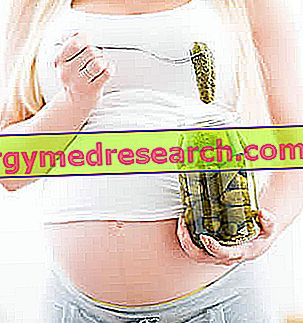Taken by the mother in gestation, certain foods in oil or pickles can be harmful to the fetus.
The main rule is to avoid any food produced at home.
Moreover, with reference to commercial foods, it is recommended to:
- DO NOT store them for long after opening them.
- Eliminate them at the first suspicion of poor storage.
What are the risks?

The pickles have a very low caloric intake and do not affect the overall nutritional balance. The pickles are more energetic, but their use can be offset by the reduction in seasoning fats.
The real danger of these preserves is related to bacterial and fungal contamination / proliferation, both during production and long storage, and after opening.
Molds
Molds, parasites, viruses and only some bacteria are killed by heat (cooking).
However, the mycotoxins of certain molds are thermostable and remain active even after the disappearance of the microorganisms that produced them.
By cooking the food to be preserved in oil and pickles, it is possible to destroy viruses, parasites and molds; on the other hand, mycotoxins can remain inside the product. For this reason, the raw materials to be used in preserves must be healthy and well preserved from the beginning.
It must be admitted that in humans mycotoxicosis, or intoxication caused by mold toxins, is rather rare.
Potentially harmful molds belong to various genera and proliferate on raw foods, but also on cooked ones (for subsequent contamination).
The foods of vegetable origin affected by the proliferation of molds are: vegetables, fruits, cereals, legumes and oil seeds.
The foods of animal origin that are affected by the aforementioned microorganisms can be:
- Seasoned (in which the colonization of beneficial molds is expected; for example, the exterior of salami, certain cheeses, etc.).
- Poorly preserved.
This means that there are "potentially good molds" and "potentially bad molds". On the other hand, the diet of pregnant women must already be starting without food of animal origin that falls into the aforementioned categories (cured meats and preserved meats, poorly stocked meat products).
The most common types of food molds are: Aspergillus, Fusarium, Penicillium and Byssochlamys .
Usually, contaminated foods are easily recognizable, which significantly reduces the risk of mycotoxicosis.
Molds can sneak into open jars and proliferate to create a white, green, red or dark and gelatinous film (the appearance changes depending on the genus and species).
To avoid this occurrence it is necessary to comply with the basic criteria for preserving preserves and pickles:
- They must not be contaminated with other foods or with saliva.
- Once opened, they must be sealed.
- They require low temperature storage.
- They should be consumed as soon as possible; the pregnant woman should avoid them if they have been open for more than a couple of days.
Bacteria
Among the bacteria there are more or less dangerous species.
The most frequent bacteria in pickles and pickles are: Staphylococcus aureus, Escherichia coli, Salmonelle and Clostridium botulinum .
Except for Salmonella, the other three types of bacteria produce exogenous toxins of a protein nature.
Salmonella and Clostridium botulinum are called sporogenous and are able to hide for a long time inside heat-resistant structures (called spores), deputies to the survival of the bacterium in hostile circumstances (acidity, high temperatures, absence of water etc.).
The universally most dangerous bacterium that affects some inks is Clostridium botulinum . This produces very dangerous neurotoxins, which give rise to a condition called botulism. Fortunately, the poisonous molecules are proteic in nature and are destroyed at 80 ° C.
In pregnancy, among the most feared bacteria we recognize Listeria monocytogenes, which gives rise to the pathology called listeriosis. It is a microorganism that increases the chances of fetal malformations and abortion. It is not easy to contract with food; much less with the well cooked pickles and pickles. In fact, Listeria monocytogenes dies at a temperature below 40 ° C and is unable to protect itself with spores. Its toxins are protein type and are destroyed by sterilization. The foods responsible for the infection are the raw foods of vegetable origin and certain cheeses.
Recall that the damage of infections, poisoning and food poisoning on the fetus is not only of a direct type . There are also indirect complications related to specific symptoms. For example, recurrent vomiting and diarrhea can cause very dangerous dehydration and nutritional suffering.
The potential for bacterial contamination and proliferation during the production cycle changes based on:
- Type of food
- Governing liquid chemistry
- Treatment temperature (whitening, pasteurization, sterilization, etc.)
- Available technology.
Specific Product and Government Liquid
FOOD TYPE
Without going into detail, let us remember that statistically, foods of vegetable origin are home to less dangerous bacterial colonies than food of animal origin.
For example, vegetables contain potentially LESS microorganisms harmful to meat.
It should also be remembered that some pickles are fermented, such as sauerkraut and gherkins made according to the traditional recipe.
The bacteria in question mainly belong to the Genus of Lactobacilli and are normally considered beneficial for the organism (probiotics). On the other hand, many believe that it is advisable to avoid them during pregnancy.
GOVERNMENT LIQUID
Also the choice of the governing liquid represents a rather effective method of microbial selection.
Acids and salts in the matrix of pickles prevent the proliferation of certain bacteria considered very harmful; the most indicative example is that of Clostridium botulinum .
On the contrary, the oil creates an oxygen-free environment that favors the metabolism of anaerobic microorganisms, which tend to be more "problematic" (which also includes the aforementioned bacterium).
Sterilization and Technology
The production of a good conserve in a jar must boast an appreciable hygienic level. However, the result may change based on the procedure adopted.
There are homemade pickles to be consumed in the short term that require a light whitening of the food (that is, a rapid passage in boiling water) and do not include pasteurization / sterilization in pots. In pregnancy they should be avoided because some sporogenic bacteria (that is spore-producing bacteria) effectively resist treatment. Germinating, spores restore microbial activity and promote the possible production of toxins.
Unfortunately, at home, this can also happen by exploiting higher temperatures and times, increasing the level of acidity and pasteurizing / sterilizing the vessels. In fact, the spores are destroyed at 120 ° C (temperature unattainable by boiling), which is why the pregnant woman should avoid the homemade pickles and pickles even if treated with heat for a long time.
At the industrial level, on the other hand, it is possible to reach and exceed this limit by promoting food security.
However, there is no treatment temperature that preserves the risk of endotoxic poisoning.
Endotoxins are lipid molecules placed on the cell surface of gram negative bacteria. This means that a food previously contaminated by these microorganisms, even if treated at very high temperatures, is able to trigger intoxication.
For this reason, very accurate hygiene is required, especially in the initial stages of the production cycle.



